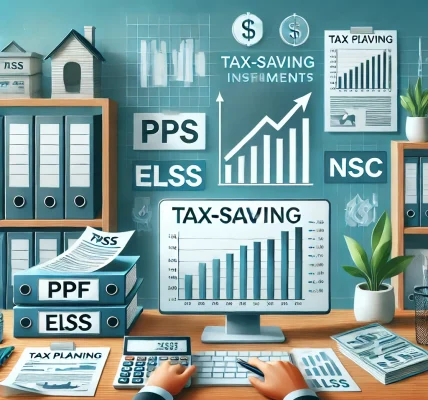Introduction
For business owners, tax planning is an essential aspect of financial management. Effective tax strategies help reduce liabilities, ensure compliance, and maximize profits. This guide provides a comprehensive, legally safe, and practical approach to tax optimization for businesses, ensuring you stay compliant while saving money.
Why Tax Planning is Essential for Business Owners?
- Maximizes after-tax income by legally reducing tax liabilities.
- Ensures compliance with tax laws to avoid penalties and audits.
- Improves cash flow by planning tax payments efficiently.
- Encourages reinvestment into business growth and expansion.
This guide covers key strategies, deductions, and compliance tips to optimize tax planning for business owners.
1. Choose the Right Business Structure
Sole Proprietorship vs. Partnership vs. Private Limited Company vs. LLP
Your business structure affects how you are taxed. Choosing the right entity can help optimize tax liability.
| Business Type | Tax Rate & Benefits |
|---|---|
| Sole Proprietorship | Taxed at individual slab rates; fewer compliance requirements |
| Partnership Firm | 30% flat tax rate; profit-sharing can reduce individual tax burden |
| LLP (Limited Liability Partnership) | 30% tax rate; no dividend distribution tax |
| Private Limited Company | 25% (for turnover up to ₹400 crores); eligible for deductions |
✅ Tip: If you plan to scale your business, forming an LLP or Private Limited Company may offer better long-term tax benefits.
2. Utilize Business Deductions & Expenses
Common Deductions for Business Owners
Taking advantage of deductions helps lower taxable income legally. Here are some major deductions:
- Rent & Utility Bills: Office space, electricity, internet, etc.
- Employee Salaries & Benefits: Wages, PF contributions, and insurance.
- Business Travel & Accommodation: Flights, hotels, transportation.
- Depreciation on Assets: Claim depreciation for office equipment and machinery.
- Professional Fees: Legal, accounting, and consultancy fees.
- Advertising & Marketing Expenses: Digital marketing, print ads, and promotions.
✅ Tip: Maintain proper invoices and records to substantiate deductions.
3. Leverage Section 80C, 80D, and Other Deductions
Even as a business owner, you can reduce personal tax liabilities using the following sections:
- Section 80C: Invest in PPF, EPF, ELSS, and life insurance to claim deductions up to ₹1.5 lakh.
- Section 80D: Claim ₹25,000-₹50,000 deduction on health insurance premiums.
- Section 80E: Deduct interest paid on education loans.
- Section 80G: Donations to registered charities offer tax exemptions.
✅ Tip: These deductions lower your taxable income while securing financial benefits.
4. Optimize GST & Input Tax Credit (ITC)
Understanding GST and ITC Benefits
- Claim Input Tax Credit (ITC): Reduce your GST liability by claiming credit on GST paid on purchases.
- Register for Composition Scheme (if eligible): Small businesses with turnover up to ₹1.5 crore can pay a lower GST rate.
- File GST returns on time to avoid penalties and interest.
✅ Tip: Use accounting software like Tally or QuickBooks to track GST payments and ITC claims.
5. Invest in Tax-Efficient Retirement Plans
Best Retirement Investment Options for Business Owners
- National Pension System (NPS): Deduction up to ₹50,000 under Section 80CCD(1B).
- Provident Fund (PPF): Tax-free returns, suitable for long-term savings.
- Equity-Linked Savings Scheme (ELSS): Tax-saving mutual funds with high returns.
✅ Tip: Diversify investments to balance tax savings and wealth accumulation.
6. Salary vs. Dividend: Pay Yourself Smartly
Which is More Tax-Efficient?
- Salary: Subject to income tax based on slab rates.
- Dividends: Taxable at 20% post-distribution.
✅ Tip: A mix of salary and dividend can reduce your overall tax burden.
7. Tax Filing & Compliance Tips
How to Stay Compliant and Avoid Penalties?
- File income tax returns (ITR) and GST returns on time.
- Maintain proper documentation for expenses and deductions.
- Conduct annual tax audits if turnover exceeds ₹10 crore (for businesses with digital transactions).
- Separate personal and business expenses to avoid confusion.
✅ Tip: Hiring a CA or tax consultant can prevent costly mistakes.
Conclusion: Maximize Savings with Smart Tax Planning
Effective tax planning helps reduce your business’s tax liabilities, improve cash flow, and ensure legal compliance.
✅ Key Takeaways:
- Choose the right business structure for tax benefits.
- Claim deductions on rent, salaries, depreciation, and advertising.
- Utilize personal tax deductions under Sections 80C, 80D, and 80G.
- Optimize GST & Input Tax Credit for cost savings.
- Invest in NPS, PPF, and ELSS for tax-efficient growth.
- Use a balanced salary-dividend approach for lower taxation.
- Ensure timely tax filings and compliance to avoid penalties.




